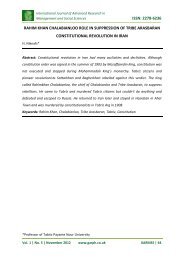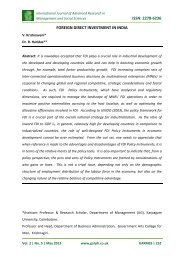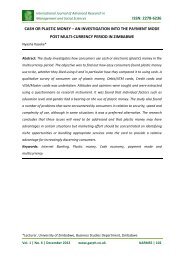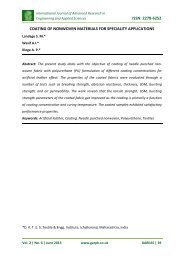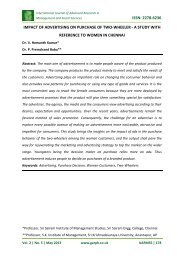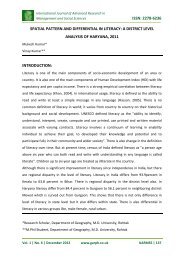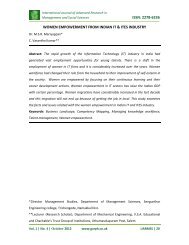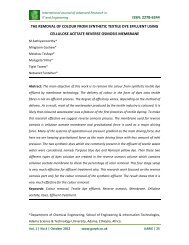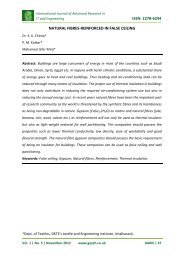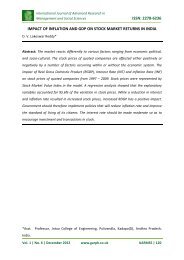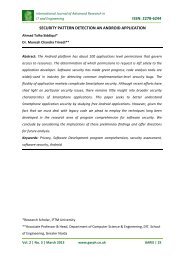issn: 2278-6236 role of breklum mission in economic ... - Garph.co.uk
issn: 2278-6236 role of breklum mission in economic ... - Garph.co.uk
issn: 2278-6236 role of breklum mission in economic ... - Garph.co.uk
Create successful ePaper yourself
Turn your PDF publications into a flip-book with our unique Google optimized e-Paper software.
International Journal <strong>of</strong> Advanced Research <strong>in</strong><br />
Management and Social Sciences ISSN: <strong>2278</strong>-<strong>6236</strong><br />
left fallow for a period <strong>of</strong> four years and spared until it rega<strong>in</strong>ed some <strong>of</strong> its fertility through<br />
renewed vegetation. Dur<strong>in</strong>g this time, they took up another clean<strong>in</strong>g for shift<strong>in</strong>g cultivation.<br />
The operation <strong>of</strong> shift<strong>in</strong>g cultivation was also known as “Podu” cultivation. The tribals<br />
<strong>co</strong>mpelled to live <strong>in</strong> wild <strong>co</strong>nditions because <strong>of</strong> the lack <strong>of</strong> resourcefulness, <strong>in</strong>feriority<br />
<strong>co</strong>mplex, primitive <strong>co</strong>nservatism and deep rooted tradition. In Koraput District, Shift<strong>in</strong>g<br />
cultivation was practised by Bonda, Dangaria Kandh, Didiayi, Koya, Gadaba, Kuttia, Kand and<br />
Paraja tribes.<br />
The major crops grown by this process were m<strong>in</strong>or millet, f<strong>in</strong>ger millet, paddy, Ragi, Jowar,<br />
Niger, and G<strong>in</strong>ger etc. Apart from that, they were cultivat<strong>in</strong>g Kuhuri (Panicum Millaceum),<br />
Maize, W<strong>in</strong>ter Paddy, Cereals, Pulses,, Millets, Panikuhuri (Pancum Millare), Swan ( Panicum<br />
frumentaceum, Jhari (Panicum Colonum), Jandal ( Sorghumvulgare), Kanga and Aga ( Setaria<br />
italic), Kalika (Phaseolus A<strong>co</strong>nti Folius), Ragi (Eleuc<strong>in</strong>e Coracene), Bajra ( Peniseturn Typhid<br />
eum) and Suan (Echnochois Frumentaceas). Other important crops were Dahi paddy<br />
(Upland paddy),Kandula ( Cajanus cajan) ,Kalaka (Penicum italicum), Kangu (penicum<br />
milcare), Janha (Sunghum vulgure),Kairi ( Millet),Kolatha ( Dolichos biflorus, horse gram),<br />
Biri ( Green gram),Maka ( Maize), Rasi ( Sesamum <strong>in</strong>dicum), Sorisa ( Mustard),Haldi (Duruma<br />
lenga), Kaunria ( Hibacus cannab<strong>in</strong>us),Jhudanga (Pulses), Gunji ( Millet), Mandia (Eleus<strong>in</strong>e<br />
Corocana),<br />
B. Terrace or Wet land cultivation<br />
This cultivation was generally carried out on flat, gentry and slop<strong>in</strong>g land <strong>in</strong> areas, where<br />
water was likely to be available or it <strong>co</strong>uld be nearly reta<strong>in</strong>ed by terrac<strong>in</strong>g. It was wetland<br />
cultivation and here the production was higher than the shift<strong>in</strong>g cultivation. Flatness was<br />
the cumulative result <strong>of</strong> centuries <strong>of</strong> erosion by ra<strong>in</strong> water <strong>in</strong> the hills, leav<strong>in</strong>g a th<strong>in</strong> layer <strong>of</strong><br />
soil. In the ra<strong>in</strong>y seasons, the fields were found wet but perhaps due to rocky nature <strong>of</strong> the<br />
terra<strong>in</strong> which generated much heat they were unfit even for wild vegetation. In w<strong>in</strong>ter, the<br />
soil became too dry to support even the growth <strong>of</strong> grass. Hence, there was natural barrier to<br />
the availability <strong>of</strong> suitable fields <strong>of</strong> slopp<strong>in</strong>g land for terrace cultivation.<br />
C. Dahi cultivation<br />
It was another form <strong>of</strong> shift<strong>in</strong>g cultivation practiced by the hill tribals. This was otherwise<br />
known as Nala. The flat hill - top or the pla<strong>in</strong> land located at the foot <strong>of</strong> the hill below the<br />
swiddens were selected for such cultivation .It was famous for grow<strong>in</strong>g turmeric on a large<br />
Vol. 2 | No. 4 | April 2013 www.garph.<strong>co</strong>.<strong>uk</strong> IJARMSS | 128





